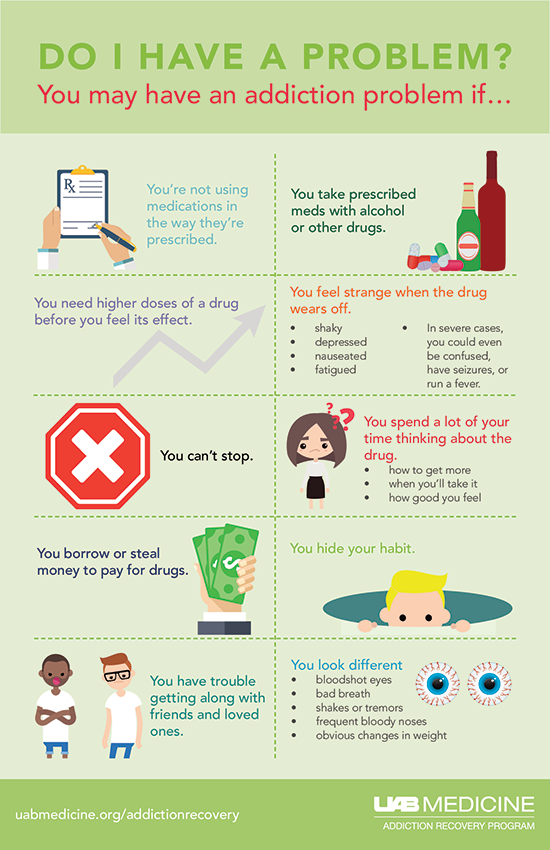 UAB experts provide insight into alcohol and substance misuse, dangers and steps one can take to minimize the risk. The misuse of alcohol and other psychoactive substances including prescription medications affects the health and well-being of millions of Americans each year. According to the Substance Abuse and Mental Health Services Administration’s 2020 National Survey on Drug Use and Health, approximately 19.3 million adults in the United States struggled with a substance use disorder in the past year.
UAB experts provide insight into alcohol and substance misuse, dangers and steps one can take to minimize the risk. The misuse of alcohol and other psychoactive substances including prescription medications affects the health and well-being of millions of Americans each year. According to the Substance Abuse and Mental Health Services Administration’s 2020 National Survey on Drug Use and Health, approximately 19.3 million adults in the United States struggled with a substance use disorder in the past year.
Substance misuse is at an all-time high. In 2020, alcohol-related deaths rose 26%, claiming approximately 150,000 lives in the United States — almost 400 deaths per day — which is the highest rate recorded in at least 40 years. In 2020, drug overdose deaths in the U.S. topped 100,000 for the first year ever, according to the CDC, and they increased another 15 percent in 2021.
Addiction can happen to anyone, and there is no single driving factor that leads to it. While some people turn to alcohol and other drugs to help cope with boredom or stress, others may use psychoactive substances to deal with a mental health condition. Some may even develop opioid use disorder after misusing prescribed opioids.
“Substance misuse is a very serious health epidemic in the United States,” said Peter Hendricks, Ph.D., professor at the University of Alabama at Birmingham School of Public Health Department of Health Behavior. “It is important to understand what a person can do to minimize the risks.”
Understanding alcohol and substance misuse
Substance misuse is defined as the repeated use of a psychoactive substance for purposes other than those for which they are meant to be used or using them in excessive amounts. Substance-use disorders occur when the recurrent use of alcohol and/or drugs causes clinically significant impairment, including health problems, disability, and failure to meet major responsibilities at work, school or home.
 Peter Hendricks, Ph.D.
Peter Hendricks, Ph.D.
(Photography: Lexi Coon)Moderate drinking, as defined by the National Institute on Alcohol Abuse and Alcoholism, is no more than one drink per day for women and no more than two drinks per day for men, translating to seven or fewer drinks per week for women and 14 or fewer drinks per week for men. A standard drink is a 12-ounce beer, 8-ounces of malt liquor, a 5-ounce glass of wine or a 1.5-ounce shot of liquor.
Alcohol consumption is the second-leading risk factor for premature death in the United States after cigarette smoking, accounting for 2.3% of all deaths among women and 6.7% of deaths among men. Among those ages 15-49 years, alcohol use is the No. 1 risk factor for premature death. Leading causes of death include tuberculosis, respiratory infections, cancer, heart disease, stroke, liver disease, unintentional injuries, self-harm and interpersonal violence. Though some research suggests that low levels of alcohol consumption might have protective effects on ischemic heart disease, these protective effects are offset by the risks associated with cancer.
Binge drinking, which is especially problematic, is four drinks in two hours for women and five drinks in two hours for men. One in six U.S. adults engage in binge drinking monthly.
“Alcohol leads to impulsive decisions and can be addictive,” Hendricks said. “Even though it’s legal for those 21 years of age and older, everyone should be aware of the dangers of drinking alcohol. Of course, adults over the age of 21 are free to make their own decisions, but my recommendation for anyone wanting to achieve optimal health is to abstain from alcohol consumption altogether. Even very moderate alcohol consumption is, in fact, unhealthy, and yes, this applies even to wine. If you’re interested in the antioxidants thought to be in wine, try eating vegetables instead. And if you enjoy the feeling of relaxation that comes with alcohol use, try exercise, meditation or just listening to your favorite music.”
Substance misuse can begin even after the very first time someone uses a drug. When some drugs are taken, they can cause surges of neurotransmitters much greater than the smaller bursts naturally produced in association with healthy rewards like eating, hearing or playing music, or social interaction. This can lead to functional changes that occur in the areas of the brain involved in reward, stress and self-control.
Dangers of alcohol and substance misuse
Megan Hays, Ph.D., associate professor and clinical psychologist in the UAB Department of Physical Medicine and Rehabilitation, notes that drinking alcohol in excess and using drugs is dangerous and can result in death.
Overdose of alcohol can occur when a person has blood alcohol content (BAC) sufficient to produce impairments that increase the risk of harm. Age, drinking experience, gender, the amount of food eaten and even ethnicity can influence BAC. Critical signs and symptoms of alcohol poisoning include:
- Confusion
- Vomiting
- Seizures
- Slow breathing
- Irregular breathing
- Hypothermia
 Megan Hays, Ph.D.
Megan Hays, Ph.D.
(Photography: Andrea Mabry)“As BAC increases, so does alcohol’s effects and the risk for harm,” Hays said. “Even small increases in BAC can decrease coordination, make a person feel sick and impair judgment. This can lead to injury from falls or car crashes, leave one more vulnerable to sexual assault or other acts of violence and increase the risk for unprotected, unintended intercourse.”
Hays explained further, “When BACs get even higher, amnesia or blackouts occur. If a person has signs of alcohol poisoning, it is very dangerous to assume that an unconscious person will be fine by ‘sleeping it off.’”
Alcohol acts as a depressant, impairing basic bodily functions, such as the gag reflex, leaving people vulnerable to choking on their own vomit and dying in their sleep. Alcohol can also irritate the stomach, making the suppression of the gag reflex especially problematic.
Other drug use can also lead to mental and physical health problems. According to the Substance Abuse and Mental Health Services Administration, cocaine is involved in nearly one in five overdose deaths and can lead to health effects including asthma, bowel decay, increased risk of HIV and increased risk of heart attack and stroke. Methamphetamine can cause permanent damage to the organs including the heart, brain, lungs and kidneys, along with skin sores, anxiety, confusion, insomnia, paranoia and aggression, among other health problems. Opioids are highly addictive and are the leading cause of overdose deaths. Opioids can lead to confusion, nausea, constipation, coma and brain damage. Cannabis (marijuana) can impact mental health and brain health.
Some symptoms of drug overdose include:
- Drowsiness, confusion and poor coordination
- Bluish tint on lips and fingernails
- Slow, shallow breathing
- Choking or gurgling sounds
- Vomiting
- Pinpoint pupils
- Clammy, pale skin
- Slow pulse or lack of pulse
- Respiratory arrest
- Loss of consciousness
Minimizing the risk
“Alcohol is ingrained in our culture, and binge drinking is perceived as a lighthearted, fun and in some cases a humorous rite of passage,” Hendricks said. “It’s crucial to communicate the dire risks of binge drinking and challenge the notion that alcohol use is a normal and harmless part of life.”
Hendricks recommends that those under the legal drinking age of 21 refrain from drinking alcohol. Moderate drinking (again, no more than two drinks per day for men and one drink per day for women) may be considered for those over the age of 21. Hendricks offers suggestions that may help reduce the harm of immoderate alcohol use:
- Alternate each alcoholic beverage with a glass of water.
- Eat a full meal before drinking occasions.
- Sip drinks slowly and avoid taking shots, chugging or using a beer bong; drinking quickly leads to a steep BAC curve and subsequent impairment.
- Do not mix alcohol with other drugs; this increases risk of toxicity and harm. Mixing alcohol with benzodiazepines (for example, Xanax and Klonopin) or opioids (including prescription pain killers) is especially problematic and can lead to death.
- Have a safe ride home by designating a driver or using public transportation, taxi or safe rides.
- Never leave your friends alone.
- Do not accept drinks from someone you do not know. Never take your eyes off of your drink.
- Intoxicated individuals cannot provide consent to sexual contact or intercourse. Sexual contact or intercourse with an inebriated person may be considered rape in most states.
 Sumayah Abed, M.D.
Sumayah Abed, M.D.
(Photography: Nik Layman)The risk of drug use has been proven to increase greatly during times of transition. Additionally, people may often turn to drugs and alcohol when something in their life is missing or not working. Sumayah Abed, M.D., assistant professor in the UAB Department of Family and Community Medicine and family medicine physician at UAB Medicine Hoover Primary and Specialty Care, say that it is important for everyone to take steps to maintain a well-balanced life. Although a well-balanced life looks different for everyone, some areas that are worth examining are the time spent between work, leisure, family and alone. The ability to prevent substance misuse begins with maintaining a proper balance between each of these things.
“Mental health conditions and substance misuse often go hand in hand,” Abed said. “In addition to maintaining a balanced life, everyone should prioritize their mental health and self-care to help reduce the chance of turning to drugs or alcohol to cope with any stressors.”
Those who are dealing with a mental health condition, such as anxiety, depression or post-traumatic stress disorder should seek the help of a trained professional for treatment before it leads to substance use. A mental health professional can help teach patients healthy coping skills that can help alleviate their symptoms without turning to drugs or alcohol.
Abed says the people that one surrounds themselves with also plays an important role in minimizing the risk of substance misuse.
“Develop healthy relationships with people who will support choices that will help you succeed and not fail,” Abed said. “The people you choose to be around should provide you with positive influences and encourage you to be a better person and make decisions that are good for your health.”
 Click image to enlarge.
Click image to enlarge.
(Graphic by: Jody Potter)The Substance Abuse and Mental Health Service Administration provides resources for those with substance use disorders and their family members. If someone is experiencing signs of overdose including agitation, lethargy, loss of consciousness, drowsiness, confusion, sickness and dehydration from poor oral intake, call 911 immediately. If someone is at risk of causing harms to themselves or others, call 911 or the National Suicide and Crisis Lifeline at 988.
The UAB Medicine Addiction Recovery Program offers an individualized approach to assessing and treating alcohol and substance use disorder. Learn more at uabmedicine.org/addiction.
